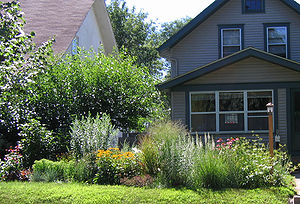
Difference between revisions of "Minnesota Stormwater Manual test page 5"
| Line 15: | Line 15: | ||
==Green stormwater infrastructure and sustainable stormwater management== | ==Green stormwater infrastructure and sustainable stormwater management== | ||
| − | *[[Overview for green stormwater infrastructure]] | + | *[[Overview for green stormwater infrastructure]] - <span title="This is a single general page, describing what GSI is, why it is important, etc."> '''Comment'''</span> |
| − | *[[Overview for sustainable stormwater management]] | + | *[[Overview for sustainable stormwater management]] - <span title="This is a single general page. The difference between this and the GSI page may seem subtle, but this page is at a higher level and brings the concepts of sustainability and ecosystem services in"> '''Comment'''</span> |
*[[Planning green stormwater infrastructure projects and practices]] - <span title="This gets at the second topic in LTech's recommendation document. That document has 4 bulleted recommendations (planning, cost, ordinances, and financing). We have to decide if each of these warrants a separate page or if all of this can be on a single page.> '''Comment'''</span> | *[[Planning green stormwater infrastructure projects and practices]] - <span title="This gets at the second topic in LTech's recommendation document. That document has 4 bulleted recommendations (planning, cost, ordinances, and financing). We have to decide if each of these warrants a separate page or if all of this can be on a single page.> '''Comment'''</span> | ||
| − | *[[Designing green stormwater infrastructure projects and practices]] | + | *[[Designing green stormwater infrastructure projects and practices]] - <span title="A single page that provides an overview of design considerations for GI, from the project level to the BMP level. Probably short and heavily linked to other pages that provide more specific information."> '''Comment'''</span> |
| − | *[[Maintaining and assessing green stormwater infrastructure projects and practices]] | + | *[[Maintaining and assessing green stormwater infrastructure projects and practices]] - <span title="A single page that provides an overview of O&M and assessment considerations for GI, from the project level to the BMP level. Probably short and heavily linked to other pages that provide more specific information."> '''Comment'''</span> |
| − | *[[Training and certification for green stormwater infrastructure]] | + | *[[Training and certification for green stormwater infrastructure]] - <span title="A single page that provides information on training and certification. This includes defining these, the importance of them, and links to resources and training/certification programs and materials."> '''Comment'''</span> |
==Green stormwater infrastructure best management practices== | ==Green stormwater infrastructure best management practices== | ||
Revision as of 16:54, 25 November 2020
Contents
Green Stormwater Infrastructure (GSI) and sustainable stormwater management
Green infrastructure encompasses a wide array of practices, including stormwater management. Green stormwater infrastructure (GSI) encompasses a variety of practices primarily designed for managing stormwater runoff but that provide additional benefits such as habitat or aesthetic value.
Water management using green infrastructure practices mimics the natural water cycle. Examples of green infrastructure practices include planting trees, restoring wetlands, enhancing biodiversity, and restoring floodplains. Green infrastructure incorporates both the natural environment and engineered systems to provide clean water, conserve ecosystem values and functions, and provide a wide array of benefits to people and wildlife. Green infrastructure can be applied on different scales, from the house or building level, to the broader landscape level. On the local level, green infrastructure practices include rain gardens, permeable pavements, green roofs, infiltration planters, trees and tree boxes, and rainwater harvesting systems. At the largest scale, the preservation and restoration of natural landscapes (such as forests, floodplains and wetlands) are critical components of green infrastructure.
Stormwater management using green infrastructure practices involves keeping and using water close to its point of origin (i.e. keeping the raindrop where it falls). Practices include those local practices mentioned above - rain gardens, permeable pavements, green roofs, infiltration planters, trees and tree boxes, and rainwater harvesting systems. Because there multiple benefits of these practices, in addition to stormwater management, the manual includes a variety of topics related to green infrastructure as illustrated below.
This page provides links to information on green stormwater infrastructure, green infrastructure, and sustainable stormwater management.
Green stormwater infrastructure and sustainable stormwater management
- Overview for green stormwater infrastructure - Comment
- Overview for sustainable stormwater management - Comment
- Planning green stormwater infrastructure projects and practices - Comment
- Designing green stormwater infrastructure projects and practices - Comment
- Maintaining and assessing green stormwater infrastructure projects and practices - Comment
- Training and certification for green stormwater infrastructure - Comment
Green stormwater infrastructure best management practices
- Overview of green stormwater infrastructure best management practices - comment
- Design considerations for green stormwater infrastructure best management practices - comment
- Operation and maintenance of green stormwater infrastructure best management practices - comment
- Assessing the performance of green stormwater infrastructure best management practices - comment
- Multiple benefits of green stormwater infrastructure - comment
Additional information on green stormwater infrastructure
- Green stormwater infrastructure case studies
- Links for green stormwater infrastructure
- Stormwater runoff performance of natural and undeveloped systems
- Checklists, inspection sheets, maintenance agreements, and model ordinances for green stormwater infrastructure
